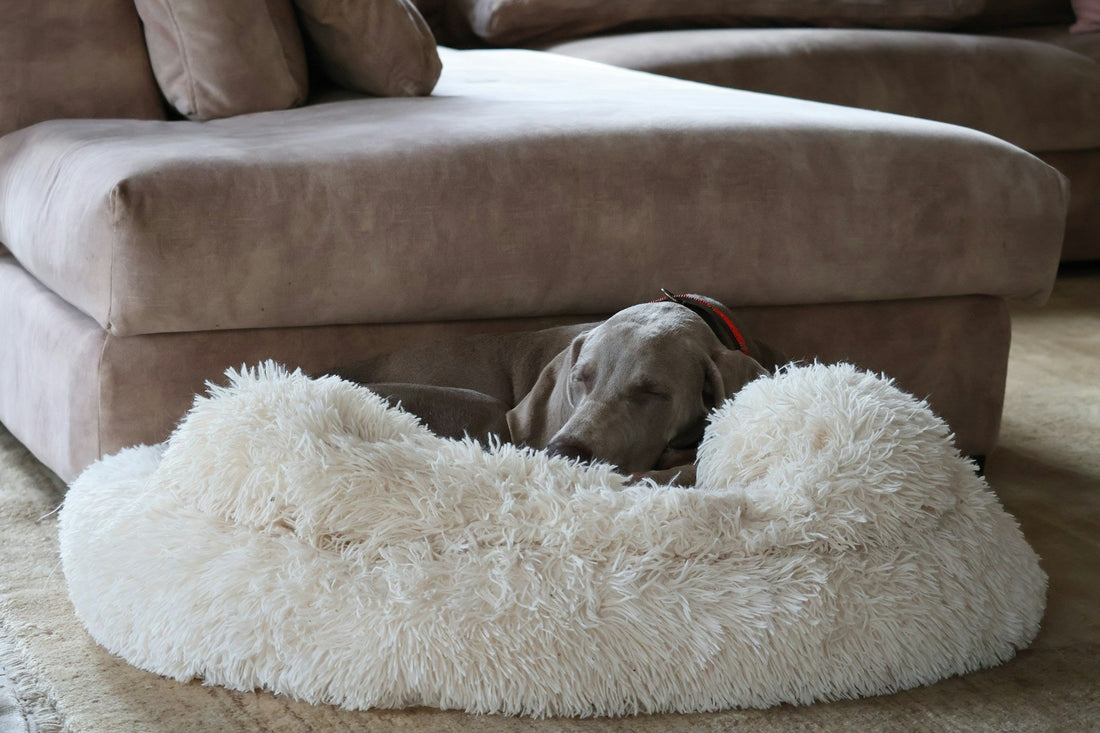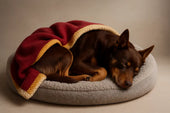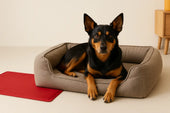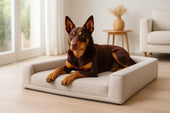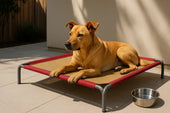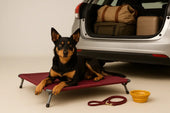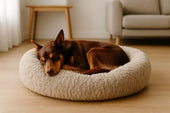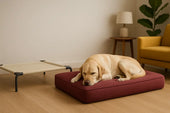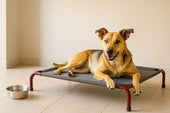Key Takeaways
- Dirty dog beds can harbour dangerous pests and pathogens—including bed bugs, fleas, bacteria, and fungi—which can affect both your dog’s and your family’s health.
- Australian homes face unique risks due to our warm climate, active lifestyles, and proximity to wildlife, making regular cleaning of dog beds even more important.
- Dogs can be bitten by bed bugs if their beds are infested, but bed bugs do not live on pets like fleas do. Regular inspection and prevention are crucial, especially after travel or guests.
- Flea infestations often start in bedding, with unwashed beds providing a safe haven for eggs and larvae. Frequent washing interrupts the flea life cycle and helps prevent re-infestation.
- Dirty bedding increases the risk of skin infections (such as dermatitis, hot spots, and fungal infections), particularly for dogs with allergies, sensitive skin, or weaker immune systems.
- Dogs have an exceptional sense of smell and are even used in Australia for professional bed bug detection, though most family dogs can’t reliably alert you to an infestation.
- After a flea infestation or illness, deep cleaning or even replacement of the dog bed may be necessary—especially if the bed can’t be fully washed or disinfected.
- Proper disinfection requires hot water, pet-safe cleaners, and thorough drying; always follow Australian veterinary advice on suitable cleaning products and frequency.
- Prevention is key: choose washable beds, maintain a regular cleaning schedule, and use vet-recommended flea preventatives for your region.
- Both pets and people can be affected by germs and pests from dog beds, making cleanliness an essential part of a healthy home.
Introduction
A dog’s bed is more than just a spot for a daily nap—it’s a place of comfort, security, and rest for your four-legged family member. Yet beneath the soft cushions and cozy covers, an unwashed dog bed can quickly become a hotspot for hidden dangers. Australian pet owners, in particular, face unique challenges: our warm, sometimes humid climate, the frequent in-and-out lifestyle of our dogs, and the proximity of native wildlife all increase the risk of pests and germs thriving where our pets sleep.
Recent research shows that up to 40% of Australian households report pet-related hygiene issues each year, often linked to bedding and soft furnishings (source: Australian Department of Health). Dirty dog beds aren’t just unsightly—they can harbour everything from bed bugs and fleas to bacteria and fungi, creating real health risks for both dogs and their owners.
If you’ve ever wondered, “Can my dog get sick from its bed?” or worried about those mysterious bites, rashes, or recurring flea problems, you’re not alone. Many caring pet owners are surprised to discover that neglecting to wash a dog bed can lead to persistent skin infections, allergic reactions, and even ongoing infestations that threaten the entire home.
This comprehensive guide uncovers the science and practical advice every Australian pet owner needs. We’ll explore:
- Whether dogs can get bed bugs from their beds,
- How dirty bedding causes skin infections,
- Why beds are the first line of defence against fleas,
- What to do after infestations or illness,
- The surprising role dogs can play in sniffing out pests,
- And the cleaning habits every Aussie family should adopt.
With input from veterinary experts, pest professionals, and real Australian pet owners, you’ll learn how to make your dog’s bed a safe haven again—and protect your family along the way.
Ready to find out what’s really lurking in your dog’s bed—and how to fix it? Let’s dive in.
Understanding the Health Risks in Dirty Dog Beds
What Lurks in a Dirty Dog Bed?
At first glance, your dog’s bed might look clean—especially if it’s covered in fur rather than mud or stains. But the reality is that, without regular washing, a dog bed becomes a magnet for an invisible array of nasties. Each day, your dog brings in dirt, pollen, grass seeds, and sometimes even parasites from the Australian outdoors. Add to that natural oils from their skin, shed fur, saliva, and the occasional accident, and you’ve got an environment that’s perfect for the growth and survival of bacteria, fungi, mites, and other pests.
A study published in PetMD found that unwashed pet beds can harbour levels of bacteria and germs rivaling those found in kitchen sinks. And, as Dr. Anne Quain from the Sydney University Veterinary Teaching Hospital points out, “Dog beds are often overlooked as a source of infection or infestation, yet they’re among the most frequently contaminated areas in a pet-friendly home.”
Why Dogs Are Vulnerable
Dogs spend a huge portion of their day resting or sleeping—on average, 12 to 14 hours per day, and even more for puppies and seniors. Their prolonged contact with bedding means they’re in close and constant exposure to anything lurking within the fibres of their bed.
Here’s why this matters:
- Dogs often have small abrasions, scratches, or sensitive skin, making it easier for bacteria or fungi to enter.
- Australian dogs are frequently exposed to the outdoors, which increases their contact with grass, soil, insects, and wildlife—all common sources of parasites and pathogens.
- Dogs with allergies, weakened immune systems, or chronic skin conditions (such as West Highland White Terriers, Staffies, or older dogs) are especially prone to developing infections from dirty bedding.
Australian homes, with open doors and outdoor play, see beds collecting dust, grass seeds, and sometimes even droppings or ticks from other pets and wildlife.
Overview Table: Common Health Risks and Their Sources
| Health Risk | Description & Effects | Main Source in Dog Beds | Why It’s a Problem in Australia |
|---|---|---|---|
| Fleas | Parasitic insects causing itch, skin infection, anemia | Flea eggs, larvae, adults | Year-round prevalence, outdoor exposure |
| Bed Bugs | Blood-sucking insects, itchy bites, skin irritation | Eggs, nymphs, adults in seams | Rising cases, travel and urban hotspots |
| Bacteria (Staph, E. coli, Salmonella) | Causes dermatitis, hotspots, sometimes severe infection | Body fluids, soil, faecal matter | Warm climate accelerates bacterial growth |
| Fungi (Malassezia, ringworm) | Yeast/fungal infections, scaly patches, chronic skin issues | Moisture, dirt, organic debris | Humidity and rain encourage mould growth |
| Mites (dust, storage, scabies) | Allergies, mange, itching, secondary infections | Dust, old food, organic matter | Frequent in dry, dusty rural areas |
| Allergens (pollen, grass, dander) | Allergic dermatitis, chronic itching | Carried in on fur, skin flakes | Australian plants/grasses highly allergenic |
Key Australian Context
- The Australian climate—with its mix of humidity, heat, and seasonal rain—creates ideal conditions for rapid growth and survival of many pests and pathogens.
- Outdoor access is common for Aussie dogs, leading to increased tracking of dirt, pollen, and pests inside.
- Wildlife (possums, birds, even bats) may introduce new bacteria and parasites to gardens and, by extension, to your dog’s bed.
Why Regular Cleaning Is Non-Negotiable
The build-up of hair, skin cells, moisture, and debris turns even the best dog bed into a breeding ground for health hazards. Dr. Kate Adams from Bondi Vet sums it up:
“Neglecting dog bed hygiene is a leading cause of persistent skin problems and recurring flea infestations. Regular, hot washes and proper drying are crucial—especially in busy Australian households.”
Can Dogs Get Bed Bugs from Their Beds?
What Are Bed Bugs?
Bed bugs (Cimex lectularius) are small, flat, reddish-brown insects that feed on the blood of warm-blooded animals—primarily humans, but also pets when the opportunity arises. Unlike fleas or ticks, bed bugs do not live on their hosts; instead, they hide in cracks, crevices, seams of mattresses and bedding—including your dog’s bed—and emerge at night to feed.
Australia has seen a rise in bed bug incidents in recent years, often linked to increased travel and the second-hand furniture market. According to the Australian Department of Health, these pests are now a problem in cities and regional areas alike, thriving in any environment where there is warmth, shelter, and a ready supply of blood.
How Bed Bugs End Up in Dog Beds
While bed bugs prefer human beds, they are opportunistic. If your dog’s bed is near your own or in an infested room, the bugs can quickly take up residence there. Bed bugs hitchhike into homes via:
- Luggage and clothing after travel (hotels, Airbnbs, trains)
- Second-hand furniture and bedding
- Visitors or new tenants
- Items brought in from infested locations (e.g., dog beds bought at garage sales or thrift shops)
Dr. Stephen Doggett, a leading entomologist with NSW Health Pathology, notes:
“Bed bugs are incredibly resilient and excellent at hiding. They can crawl into almost any fabric item, including pet beds, and survive for months without feeding.”
Can Dogs Be Bitten by Bed Bugs?
Yes, dogs can be bitten by bed bugs if their beds or sleeping areas are infested. Bed bugs do not live on pets, but they will bite any available host. Bites usually appear as:
- Small, red, itchy bumps (often in clusters)
- Inflamed or irritated skin, especially on parts of the body with less fur
- Restlessness or increased scratching, particularly at night
Australian Case Example:
A 2021 Sydney household found bed bugs had migrated from the children’s bunk beds into the family dog’s bedding. The dog showed signs of itching and small red welts, which were initially mistaken for flea bites, only to be identified as bed bug bites after a professional inspection (source: ABC News).
What to Do if You Suspect Bed Bugs
Inspect the Bed:
- Use a torch to check seams, folds, and tags on your dog’s bed for tiny brown bugs, shed skins, and black “pepper-like” droppings.
- Check for small blood stains on the fabric.
Isolate and Clean:
- Remove the dog bed from the room and place it in a sealed plastic bag if possible.
- Wash the bed in hot water (at least 60°C) and dry on high heat.
- Clean surrounding areas—carpet, baseboards, nearby furniture.
When to Call Pest Control:
- Bed bug infestations are notoriously difficult to eradicate without professional help.
- Seek help from a licensed pest controller, ideally one familiar with pet-safe treatment options.
Expert Commentary & Australian Perspective
- According to the Australian Government’s Bed Bug Code of Practice, homes with pets may face more complicated infestations since bugs can spread between pet bedding and human sleeping areas.
- RSPCA Australia reminds owners that regular inspection and hot washes of all bedding are vital in breaking the cycle.
“Bed bugs can survive in pet beds just as easily as they do in human beds. Early detection and immediate action are essential to prevent a widespread household infestation.”
— Dr. Katrina Warren, PetSure Australia
Can a Dirty Dog Bed Cause Skin Infections?
Skin Infections Linked to Bedding
Dogs spend a large part of their lives curled up in their beds. If those beds are rarely washed, they quickly become a reservoir for germs. Just as dirty pillowcases can cause skin breakouts in people, dirty dog beds put dogs at risk for a range of skin problems—many of which are surprisingly common in Australia.
Dirty bedding allows pathogens to thrive, including:
- Bacteria: such as Staphylococcus pseudintermedius (a major cause of canine pyoderma), E. coli, and sometimes even Salmonella.
- Yeasts: most notably Malassezia pachydermatis, which causes skin irritation and secondary infections.
- Fungi: including the organisms responsible for ringworm.
- Mites and other parasites: these thrive in dusty, dirty bedding and can trigger skin issues or allergies.
A PetMD feature highlights that pet beds are among the most bacteria-laden objects in a household, often dirtier than a toilet seat or kitchen sink if not cleaned regularly.
Common Culprits in Australia
Australian conditions—hot summers, high humidity in coastal areas, and dust in rural zones—create an ideal environment for microorganisms and mites. Many native plants shed pollen and spores that stick to dogs’ fur, then settle into beds. Combine this with the Australian love for “inside-outside” pets and you have a perfect storm for allergen and microbe buildup.
- Bacterial hot spots: Warm, moist fabric creates ideal conditions for staph bacteria and other pathogens to multiply.
- Yeast overload: Dogs with allergies, folds in their skin, or prone to ear infections are also more likely to develop yeast infections from dirty bedding.
- Ringworm: While not a worm but a fungus, ringworm can spread via contaminated bedding, especially in multi-pet households or shelters.
- Mites: Australia’s dry and dusty regions are hotspots for dust and storage mites, both of which can aggravate dog allergies and cause itchy skin.
Recognising the Symptoms
Signs that your dog’s skin is being affected by a dirty bed include:
- Persistent scratching, licking, or chewing at certain spots
- Red, inflamed skin or rash
- Bald patches or thinning fur
- Hot spots (moist, rapidly spreading sores)
- Greasy or foul-smelling skin (a sign of yeast overgrowth)
- Scabs, blisters, or crusty patches
- Reluctance to use their bed or restlessness at night
Dogs with allergies or compromised immune systems (including older dogs, puppies, or those with chronic health problems) are especially vulnerable.
Data & Research
According to a 2019 Australian Veterinary Association report, skin issues such as allergic dermatitis and bacterial pyoderma are among the top five reasons for veterinary visits in dogs. The report highlights that poor hygiene—including infrequent washing of bedding—is a significant contributing factor.
Dr. Anne Quain, a lecturer at the University of Sydney School of Veterinary Science, adds:
“It’s not unusual for us to see dogs with chronic or recurring dermatitis where the source turns out to be their bedding. Many owners don’t realise how quickly bacteria and yeast can build up in those soft fibres, especially in a warm Aussie home.”
Prevention and Early Detection
What can you do?
- Wash bedding weekly in hot water (at least 60°C) and dry thoroughly.
- Vacuum around dog sleeping areas to reduce allergens, dust mites, and pollen.
- Use hypoallergenic, fragrance-free detergents and avoid harsh chemicals that may irritate your dog’s skin.
- Inspect your dog’s skin regularly, especially in spring and summer when allergies peak.
- Consult your vet promptly if you notice persistent skin problems—sometimes a simple bedding change or more frequent washing can resolve chronic issues.
Dr. Kate Adams of Bondi Vet puts it simply:
“Don’t underestimate the power of clean bedding. For many itchy or rash-prone dogs, it’s the single most effective change you can make at home.”
Can Dirty Dog Beds Lead to Flea Infestations?
Flea Biology & Bed Life Cycle
Fleas (Ctenocephalides felis, the cat flea, which also infests dogs) are among the most common and frustrating parasites facing Australian pet owners. While adult fleas live on your dog, most of their life cycle—eggs, larvae, and pupae—takes place off your pet, primarily in soft furnishings like bedding, carpets, and even cracks in floorboards.
Key facts about fleas and bedding:
- Adult fleas lay eggs on your dog, but these eggs quickly drop off into the environment, especially your dog’s favourite sleeping spots.
- Larvae avoid light and burrow deep into bedding and soft furniture, feeding on organic debris and “flea dirt” (the faeces of adult fleas).
- Pupae (in protective cocoons) are almost impossible to kill with surface sprays and can survive in bedding for weeks or even months, waiting for the right conditions (warmth, vibration) to hatch.
According to the RSPCA, more than 90% of a household flea problem is in the environment, not on the pet itself.
Dirty Beds as a Flea Magnet
Neglected dog beds—especially those rarely washed or located in humid or shaded areas—become prime real estate for fleas to breed and multiply. Dirt, shed fur, and crumbs all create food and shelter for flea larvae.
Why does this matter in Australia?
- Year-round risk: Unlike cooler climates, many parts of Australia have mild winters, allowing fleas to thrive all year, especially indoors.
- Outdoor lifestyle: Many Aussie dogs go in and out multiple times a day, tracking flea eggs and dirt from the yard to their beds and back again.
- Wildlife and feral animals: Fleas are easily transferred from native wildlife or stray cats to pets via the garden or shared spaces.
Signs of Flea Infestation in Beds
Not sure if your dog’s bed is harbouring fleas? Look for:
- Flea dirt: Tiny black specks that turn reddish-brown when moistened—these are flea faeces, composed mostly of digested blood.
- Eggs and larvae: Eggs look like white grains of sand; larvae resemble tiny white worms.
- Live fleas: Adults may be spotted crawling on the bed or in the seams during a heavy infestation.
- Itchy dog: Increased scratching, biting at their skin, or restlessness—especially after lying on the bed.
Expert Tip: Dr. Katrina Warren of PetSure Australia notes,
“The first place I check during a suspected flea infestation is always the bedding and favourite nap spots. If you see flea dirt or live fleas, assume the whole house needs treatment, not just your dog.”
Health Risks for Dogs and Humans
- Flea allergy dermatitis: Many dogs are allergic to flea saliva, resulting in severe itching, hair loss, and sores.
- Tapeworms: Fleas carry tapeworm larvae, which can infect your dog if swallowed during grooming.
- Anaemia: Severe infestations, particularly in puppies or smaller breeds, can lead to dangerous blood loss.
- Zoonotic risk: Fleas can bite humans, especially children, causing itchy welts and sometimes spreading disease.
Preventing & Breaking the Cycle
Regular washing and cleaning are the most effective ways to keep fleas at bay:
- Wash your dog’s bedding weekly in hot water (at least 60°C).
- Dry thoroughly on high heat—flea eggs and larvae cannot survive high temperatures.
- Vacuum sleeping areas and surrounding carpets frequently, emptying the vacuum outside to prevent reinfestation.
- Treat all pets in the household with vet-approved flea preventatives, especially during peak flea season (spring and summer).
Choice Australia recommends using both chemical (pet-safe sprays or powders) and physical (washing, vacuuming) methods for the best results.
The RSPCA also stresses:
“Washing your pet’s bedding weekly in hot water is one of the simplest and most effective ways to prevent a flea infestation in your home.”
Can Dogs Smell Bed Bugs? Science-Backed Answers
The Canine Nose: Facts and Research
It’s well known that dogs have a sense of smell far superior to that of humans. Research suggests that dogs have up to 300 million scent receptors in their noses (compared to around 6 million in humans), allowing them to detect scents at concentrations as low as parts per trillion.
This extraordinary olfactory ability is used by dogs around the world—including Australia—not only for tracking and search-and-rescue, but for detecting everything from illegal drugs to medical conditions, and, more recently, bed bugs.
A 2016 ABC News report highlighted how pest control companies in Australia now use specially trained dogs to sniff out bed bugs in hotels, apartments, and private homes. These dogs can detect infestations long before humans notice any bites or visible bugs.
Bed Bug Detection Dogs in Australia
Professional “bed bug dogs” are increasingly common in Australia’s major cities, especially in the hospitality and travel industry where infestations can spread quickly and discreet detection is vital. These dogs are trained to identify the unique scent of live bed bugs and their eggs—even through walls, under carpets, and inside mattresses.
Dr. Stephen Doggett, entomologist and head of Medical Entomology at NSW Health Pathology, explains:
“Detection dogs have proven to be incredibly accurate and efficient, allowing us to find and treat infestations before they become widespread. Their use is a game changer for pest management in Australia.”
How are these dogs trained?
- Positive reinforcement: Dogs are rewarded with treats or toys when they correctly indicate the presence of bed bugs.
- Regular practice: They train with real bed bugs in controlled conditions to hone their accuracy.
- Handlers: Professional handlers work closely with dogs to interpret their signals and confirm findings.
Can Family Pets Alert Owners?
While only professionally trained dogs can reliably detect bed bugs, many pet owners notice their own dogs acting strangely around infested areas. Some anecdotal reports from Australian households suggest that dogs will sniff, paw at, or avoid beds and couches where bed bugs are hiding, but these behaviours are not a guarantee of an infestation.
What should you look for?
- Persistent sniffing, pawing, or chewing at seams and corners of bedding or furniture
- Reluctance to settle in a specific spot they used to enjoy
- Signs of itching or discomfort after using their bed
Remember: A dog’s behaviour alone is not proof of bed bugs—physical evidence is still required. If you notice both your dog acting unusual and other signs (bites, black spots, shed skins), it’s time to inspect more closely or call a professional.
Limitations and Best Practices
- Untrained dogs are not a substitute for professional pest detection. While some dogs may notice new or strange scents, they are not as consistent or specific as trained detection dogs.
- Bed bug detection is a team effort. In Australia, professional pest control services with detection dogs are available in major cities, and many offer pet-safe treatment options if bed bugs are found.
- Keep dog beds clean and check regularly. This not only helps prevent pests but can alert you to problems before they get out of hand.
Dr. Doggett sums up:
“Relying on your dog’s sense of smell alone isn’t enough, but dogs have proven invaluable in Australia’s fight against bed bugs. For pet owners, regular cleaning and vigilance are still your best defence.”
Should You Replace Your Dog’s Bed After a Flea Infestation?
Assessing the Situation
Discovering fleas on your dog is stressful, but realizing they’ve set up shop in your home—and especially your pet’s bed—can be overwhelming. One of the biggest questions owners face is whether a good wash is enough, or if it’s safer to throw the whole bed out.
Key questions to ask yourself:
- Is the bed machine-washable, including the inner filling?
- Is there a removable cover, or is the bed one solid piece?
- Is the infestation minor, or are there clear signs of heavy contamination (live fleas, eggs, larvae, and persistent odour)?
Washing vs. Replacing: What Experts Say
Washing is often enough if:
- The entire bed (including covers and filling) can be washed in hot water—at least 60°C—as recommended by Choice Australia.
- The bed can be tumble-dried on a hot setting (high heat is critical to kill fleas at all life stages).
- You use a pet-safe, vet-recommended detergent or disinfectant (avoid anything with strong perfumes or toxic chemicals).
When you should consider replacing:
- The bed can’t be washed thoroughly, or is too large for your washing machine.
- Fleas return quickly after cleaning, suggesting eggs or pupae are buried deep in foam or filling.
- The bed smells musty, remains stained, or your dog’s skin issues don’t improve.
- Your dog or household members have severe allergies or are immunocompromised.
Dr. Katrina Warren, veterinary advisor at PetSure Australia, explains:
“If a bed can’t be cleaned with hot water and dried at a high temperature, replacement is usually the safest—and most hygienic—option. Persistent infestations almost always mean eggs or pupae survived deep in the material.”
Environmental Considerations
While it can be tempting to simply throw away an infested bed, it’s worth considering the environmental impact. Many councils across Australia have specific guidelines for disposing of large or contaminated soft furnishings.
Tips for responsible disposal:
- Check your local council’s rules on disposing of textiles or “hard rubbish.”
- If the bed is badly infested, wrap it in a sealed garbage bag to avoid spreading fleas during transport.
- When purchasing a new bed, opt for washable, durable materials with removable covers—many Australian brands now offer eco-friendly, easy-clean beds designed for our climate.
Case Examples & Vet Advice
A Brisbane dog owner, Emily, faced a persistent flea problem despite using spot-on treatments:
“We tried washing the bed several times but the fleas kept coming back. Our vet explained that the eggs were probably deep inside the foam. We replaced the bed and treated the house at the same time—and finally, the problem was solved.”
Vets and pest professionals alike recommend a two-pronged approach:
- Treat the environment (wash or replace the bed, vacuum, and clean the house)
- Treat the dog (vet-approved flea prevention)
The RSPCA stresses that keeping bedding clean is just as important as treating the pet:
“Successful flea control always involves both environmental management and regular washing of all bedding in hot water.”
How to Disinfect a Dog Bed After Illness or Accidents
When and Why to Disinfect
Cleaning up after your dog’s illness, diarrhoea, vomiting, or even routine accidents is more than just a matter of keeping things fresh. Dirty or contaminated bedding can harbour bacteria, viruses, and parasites that pose risks not just to your dog, but to everyone in the household—especially young children, older adults, and immunocompromised family members. In Australia, where warm and humid conditions can allow microbes to thrive, disinfection is a must after any mess or outbreak.
The Australian Veterinary Association explains:
“After illness or an accident, dog bedding should always be washed and disinfected as soon as possible to prevent reinfection or spread of disease.”
Step-by-Step Guide to Deep Cleaning
-
Remove all covers and bedding:
- Take off any removable covers and separate them from the inner cushion or stuffing.
- Shake out loose debris, fur, and dirt outdoors to prevent spreading germs indoors.
-
Pre-treat stains and soiling:
- Rinse away vomit, faeces, or urine with cold water.
- For tough stains, use a pet-safe, enzymatic cleaner like Nature’s Miracle (widely available in Australia) or a diluted mix of white vinegar and water.
-
Wash in hot water:
- Use your washing machine’s hottest cycle (at least 60°C).
- Add an extra rinse to ensure all detergent is removed—important for sensitive-skinned dogs.
-
Disinfect with a pet-safe solution:
- F10SC Veterinary Disinfectant is a gold standard in Australian vet clinics. It’s non-toxic, safe for pets, and proven to kill a wide range of pathogens (see F10 Australia).
- For a more natural approach, add one cup of white vinegar to the wash cycle for mild disinfection and odour removal.
-
Dry thoroughly:
- Use the dryer’s highest heat setting that’s safe for the bed, or hang bedding in direct sunlight (UV rays are a natural disinfectant and very effective in the Australian climate).
- Ensure the inner cushion is completely dry to avoid mould or mildew.
-
For non-washable beds:
- Use a steam cleaner or spray with a pet-safe disinfectant and allow to air dry completely.
- If the bed is heavily contaminated or you suspect a serious infectious disease (like parvovirus), replacement is often safest—some pathogens are extremely hardy and can survive standard cleaning.
Products and Ingredients to Use and Avoid
-
Safe to use:
- Hot water, hypoallergenic laundry detergents, white vinegar, F10SC Veterinary Disinfectant, mild enzymatic cleaners.
-
Avoid:
- Harsh chemicals like bleach (unless highly diluted and fully rinsed), ammonia, and strong perfumed detergents, as these can irritate your dog’s skin or cause toxic reactions.
The RSPCA notes:
“Choose cleaning agents approved for pet use and always rinse thoroughly to ensure no residues remain.”
How Often Should You Clean?
- After illness, accidents, or pest infestations: Immediately, following the deep cleaning steps above.
- Routine maintenance: Weekly washes in hot water are recommended for active, outdoor, or allergy-prone dogs. For indoor-only pets, every two weeks may be sufficient.
Tips for Future-Proof Hygiene
- Keep a spare bed or cover on hand so your dog has somewhere to rest while the primary bed is being washed and dried.
- Use machine-washable beds with removable covers to make regular cleaning easier.
- Vacuum and wipe down the area around your dog’s bed—this helps remove dirt, hair, and any lingering bacteria or allergens.
Dr. Anne Quain from Sydney University Veterinary Teaching Hospital advises:
“Prompt, thorough cleaning of pet bedding after illness not only helps your dog recover faster but protects the entire household from avoidable infection.”
Frequently Asked Questions
How often should I wash my dog’s bed?
For most Australian homes, washing your dog’s bed weekly in hot water (at least 60°C) is ideal. If your dog spends a lot of time outdoors, is prone to allergies, or sheds heavily, you may need to clean it even more often. After any illness, accident, or suspected pest infestation, always clean and disinfect immediately.
Tip: Keeping a second bed or set of covers makes it much easier to stick to a cleaning routine.
What temperature is best for killing pests and germs?
Washing at 60°C (140°F) or higher is most effective for killing fleas, bed bugs, mites, bacteria, and many viruses. If the bed can’t be washed at this temperature, use a steam cleaner or consider replacing the bed in cases of infestation or illness.
Are there dog beds that resist pests better than others?
Yes! Beds with tightly woven synthetic fabrics, minimal seams, and removable, machine-washable covers are far less likely to harbour pests and are much easier to keep clean. Avoid overly plush, ornate beds that are difficult to wash thoroughly.
Choice Australia recommends choosing pet beds specifically marketed as “easy clean” or “allergy friendly.”
Can dirty dog beds make people sick?
Absolutely. Fleas, mites, and many bacteria or fungi found in dirty bedding can transfer to humans, particularly children, older adults, or those with weakened immune systems. Always wear gloves when handling soiled bedding and wash your hands thoroughly after cleaning.
How do I know if my dog’s bed has bed bugs or fleas?
Look for:
- Bed bugs: Tiny brown bugs, shed skins, small blood spots, black “pepper-like” droppings, and clusters of itchy red bites (especially on hairless parts of your dog).
- Fleas: Black specks (“flea dirt”), live fleas, flea eggs (white grains), and increased scratching, especially after lying on the bed.
If you suspect either pest, inspect all sleeping areas, vacuum thoroughly, wash all bedding on hot, and consult your vet or a professional pest controller.
Should I use bleach to disinfect my dog’s bed?
Avoid bleach unless absolutely necessary, and only if it can be thoroughly rinsed out—residues are irritating and even toxic for pets. Opt for pet-safe disinfectants like F10SC (used in many Australian vet clinics) or enzymatic cleaners. White vinegar is a safe, natural option for light disinfection and odour removal.
What if my dog won’t use their bed after it’s been cleaned or replaced?
Some dogs are sensitive to new smells or unfamiliar fabrics. If your dog avoids a freshly cleaned or new bed:
- Use an unscented, hypoallergenic detergent.
- Place a favourite old toy or blanket on the bed.
- Give positive reinforcement when your dog uses the bed.
“A clean bed may smell different, but most dogs quickly adapt. If your dog is persistently avoiding their bed, check for residual scents, fabric irritation, or consult your vet,” advises Dr. Kate Adams from Bondi Vet.
Do I need to treat the whole house if I find fleas or bed bugs in my dog’s bed?
Yes. Fleas and bed bugs can quickly spread to carpets, furniture, and other soft furnishings. Treat your dog, wash all bedding and blankets, and vacuum the entire home. For severe or recurring infestations, call a pest professional with experience in pet-safe treatments.
Product Recommendations & Best Practices
Features to Look for in a Dog Bed
Choosing the right dog bed is one of the best ways to keep your pet healthy and make cleaning easy. When selecting a bed for your dog—especially in Australia’s climate—consider these features:
- Removable, Machine-Washable Covers: These make regular cleaning simple and effective.
- Durable, Synthetic Fabrics: Tight weaves are less likely to harbour fleas, mites, and bed bugs compared to plush or heavily textured materials.
- Minimal Seams and Crevices: Beds with few seams, zippers, or folds provide fewer hiding spots for pests and make cleaning more thorough.
- Supportive, Quick-Drying Filling: Choose beds with foam or fill that can withstand hot water or spot cleaning, and that dry quickly to prevent mould.
- Non-slip Base: Helps keep the bed in place and prevents moisture from seeping underneath, especially in humid or rainy environments.
Pro tip: Browse our range of washable dog beds and easy-clean bedding accessories designed for active Australian pets.
Safe Cleaning Products for Dog Beds
- Pet-safe laundry detergents: Use fragrance-free or hypoallergenic formulas to avoid skin irritation.
- Enzymatic cleaners: These break down organic messes (like urine, vomit, or faeces) and are widely available in pet stores across Australia.
- F10SC Veterinary Disinfectant: Highly effective, used in vet clinics, and available for home use.
- White vinegar: An affordable, natural option that helps kill bacteria and neutralise odours.
Avoid: Harsh chemicals like undiluted bleach, ammonia, or heavily perfumed cleaners, which can be toxic or irritating for pets.
Cleaning Routine Best Practices
- Wash bedding weekly in hot water (minimum 60°C).
- Vacuum and clean the area around your dog’s bed regularly to reduce dust, fur, and allergens.
- Keep a spare cover or bed to make regular washing less disruptive for your dog.
- Rotate beds if you have more than one pet, and always wash both after an infestation or illness.
When to Upgrade or Replace Your Dog’s Bed
- If the bed remains musty, stained, or harbours pests after cleaning.
- When the filling clumps or loses support, which can contribute to joint pain.
- After any major flea or bed bug infestation where cleaning is not effective.
Explore your collection of machine-washable dog beds, bedding accessories, and pet-safe cleaning products.
Conclusion
Your dog’s bed is more than just a place to rest—it’s a cornerstone of their daily comfort and well-being. But as you’ve seen, what lurks within that soft, familiar space can pose serious risks if hygiene is neglected. Bed bugs, fleas, bacteria, and fungi all thrive in dirty bedding, especially in Australia’s varied and often pet-friendly climate.
The good news? Most of these dangers are easily preventable with regular, thorough cleaning and a proactive approach. Washing bedding weekly in hot water, vacuuming surrounding areas, and choosing beds made from easy-clean materials will go a long way in safeguarding your dog’s health. When infestations or illnesses do strike, immediate action—whether it’s a deep clean or, in some cases, replacing the bed—is the best way to protect both your pet and your family.
Australian pet owners have a unique set of challenges, from our active, outdoor lifestyles to a climate that encourages pests year-round. But armed with expert guidance, a regular cleaning routine, and the right products, you can make your home a safe haven for your furry companion.
Remember:
- Inspect your dog’s skin and bed regularly for any signs of irritation or pests.
- Consult your vet if you notice persistent skin problems or recurring infestations.
- Make dog bed hygiene part of your household routine—your pet’s health (and your peace of mind) depend on it.
If you’re looking for beds that are easy to wash, tough on pests, and comfortable for your dog, explore our selection of machine-washable dog beds and pet care essentials designed for Aussie homes.
By staying informed and proactive, you’re giving your dog not just a comfortable spot to sleep—but a healthier, happier life.

